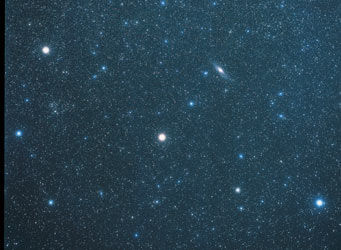
Alpha Andromedae (bottom right bright star), the head of the constellation Andromeda and a corner of the Great Square of Pegasus likely sports mercury in its stellar atmopshere.
Akira Fujii
Look closely enough and stars can get more puzzling than anyone expects. According to a new paper out last week, some stars display heavy-metal "weather" patterns where astronomers expected they should have none.
For nearly a century, astronomers have known that a hot star with a strong magnetic field can show signs in its spectrum of different heavy elements enriching different patches of its surface. These are the chemically peculiar A and B stars known as "spectrum variables." A star that's hot enough to have an A or B spectral type is too hot to have a convective, churning outer layer like the Sun's. If the star is a slow rotator to boot, its atmosphere can be so still and stable that radiation pressure delicately sorts out atoms of various heavy elements and pushes them into a thin, rich layer in the star's upper atmosphere. A strong magnetic field can segregate the elements in this layer — so that, for instance, a peculiar A star can show a mercury-and-manganese side, or a chromium-and-europium side.
Now a study (released in the June 24th Nature Physics) has found localized, changing mercury clouds on a star with no strong magnetic field — creating a new puzzle about what could be causing such stellar weather.
Alpha Andromedae, the head of the constellation Andromeda and a corner of the Great Square of Pegasus, is a B9.5 subgiant with a high abundance of mercury and manganese and no measurable magnetic field. Nevertheless, seven years of spectral monitoring showed spotty mercury clouds that change a lot from year to year. "That there were mercury clouds was surprising," says Austin Gulliver (Brandon University, Manitoba), one of the authors of the paper. "That they can vary according to weather is doubly surprising."
The astronomers were able to map the mercury patches on Alpha Andromedae by tracking the Doppler-shift profiles of a mercury line in the star's spectrum while the star rotated. The astronomers found that the mercury concentration at the star's poles is 250 times what it is in the Sun, but up to 2.5 million times the Sun's value along the star's equator. And, they say, several large mercury clouds at low and intermediate latitudes distort this pattern. Some of the clouds changed density by a factor of 100 between 1998 and 2004.
"Our analysis is the first to reveal evolving chemical inhomogeneities, apparently unrelated to any magnetic fields, in any star, " the team writes. "Similar to planetary atmospheres, the outermost layers of stars are sites of dynamical processes of structure formation and self-organization."
 0
0
Comments
You must be logged in to post a comment.